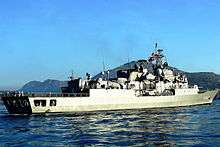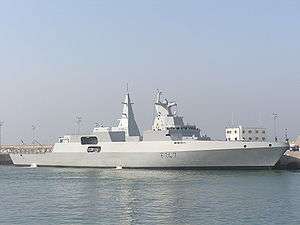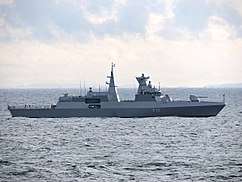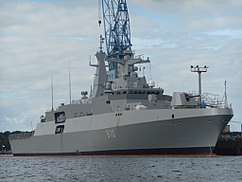MEKO 200
The MEKO 200 is a frigate design by the Blohm + Voss shipyard of Germany, as part of the MEKO family of warships.
.jpg) Turkish Navy frigate TCG Oruç Reis departing from Portsmouth Naval Base in the United Kingdom, on 21 September 2009. Off the bows in the distance is Fort Gilkicker, and beyond (to the left) the Isle of Wight. | |
| Class overview | |
|---|---|
| Builders: | Blohm + Voss |
| Operators: | |
| In service: | 1987–present |
| Completed: | 25 |
| Active: | 25 |
| General characteristics | |
| Type: | Frigate |
| Displacement: | 3,400 tons (full load) |
| Length: | 118 m (387 ft) |
| Beam: | 14.8 m (49 ft) |
| Draught: | 4.3 m (14 ft) |
| Propulsion: | 1 × General Electric LM2500+ gas turbine and 2 × MTU 12V1163 TB83 diesel engines, driving two shafts with controllable pitch propellers in CODOG configuration. |
| Speed: | 32 knots (59 km/h) |
| Range: | 6,000 nautical miles (11,000 km) at 18 knots (33 km/h) |
| Complement: | 220 |
| Sensors and processing systems: |
|
| Electronic warfare & decoys: |
|
| Armament: |
|
| Aircraft carried: |
|
Variants
Anzac class (MEKO 200)
Ten MEKO 200 frigates were built to the Anzac-class design: eight for the Royal Australian Navy, and two for the Royal New Zealand Navy.
The Australian Department of Defence decided to upgrade their Anzacs even before all ships were completed, the upgraded configuration includes— RGM-84 Harpoon anti-ship missiles fitted in two quad launchers, Evolved Sea Sparrow missiles quad-packed in VLS enabling 32 missiles to be carried, four Nulka active missile decoy bays, and the TSM 5424 Petrel mine and obstacle avoidance sonar system. All upgrades and new builds are scheduled for completion by 2006.
In 2004 Tenix, Saab, and the Australian Department of Defence formed a Private Public Partnership to upgrade the anti-ship missile defence capability of the Anzac class. This upgrade will include Sagem Vampir NG IRST (infra-red search and track) capability, Saab 9LV Combat Management System upgrade and CEA Technologies PAR 3D E/F band fixed active phased array radar and illuminator. A new main mast will be constructed to incorporate the CEAFAR and CEAMOUNT systems and maintain the existing 2D radar and electronic surveillance capabilities.
Yavuz/Barbaros class (MEKO 200TN)

The Turkish variant, MEKO 200TN, is a modified MEKO 200 type multirole frigate. The first order for the Turkish Navy was signed during April 1983 with two MEKO 200TN built in Germany and two built in the Gölcük shipyards in Turkey. The vessels are also known as MEKO 200TN Track I or Yavuz class. Two more orders followed, each known as Track IIA Barbaros class and Track IIB. The Yavuz-class frigates have adopted the CODAD propulsion method with 4 MTU 20V Diesel engines, which require a substantial amount of maintenance. There were also questions over the selection of the Swiss manufactured Sea Zenith, an advanced CIWS system that was never previously used on any naval platform, but there have been no negative reports regarding the system's performance from the Turkish Navy. The later Track IIA frigates have incorporated major improvements including the CODOG propulsion method with two MTU 16V diesel engines and two LM2500-30 gas turbines, a greater displacement of 3,350 tons (full load) and the replacement of the older Mk-29 Sea Sparrow launcher with the Mk-41 Mod 8 VLS.
These frigates are considered to be used not for naval superiority but rather as sea-denying assets that will try to inflict maximum damage to the enemy, while trying to keep friendly casualties low. MEKO200TN Track I/IIA/IIBs have a maximum speed of 27/31+ knots, with a range of 4,000 nautical miles (7,400 km; 4,600 mi) at a speed of 20/22 knots. Their armament includes the FMC Mk 45 127 mm/54 caliber gun, eight RGM-84 Harpoons, two triple-mounted Mk 32 324 mm torpedo tubes, and 8/16 RIM-7 Sea Sparrow missiles. Electronic equipment includes the DA 08/ AWS-9 surface/air surveillance radar, the WM 25/ AWS 6 tracking radar, the TM 1226/ 2690BT ARPA navigation radar, and STACOS TU/FD Tactical Command and Control System. The Turkish frigates are also equipped with WM25/ COSYS DDWCS Fire Control System, a DE1160 sonar, and Link 11/14 VESTA CDL2, MCS2002 communication systems.
Vasco da Gama class (MEKO 200PN)
.jpg)
The Vasco da Gama class, a development of the MEKO 200 PN German concept, are major surface ships of the Portuguese Navy. Portugal operates three ships of this class, which were built in Kiel by Blohm + Voss and later by HDW, using modular construction techniques. These vessels are unique in the MEKO 200 family as they are the only ones equipped with the French 100mm naval gun as their main gun.
The project for the construction of three frigates of this class was authorized by the Portuguese Government in 1985, five years after the request of the Portuguese Navy for the acquisition of new surface ships.
Hydra class (MEKO 200HN)
_23_10_06_1138.jpg)
The MEKO frigates have high-level specifications for shock resistance, stiffness requirements for the fire control and radar systems, and blast and gas pressure resistance to retain the integrity of the on-board weapon systems. The hull is constructed of high tensile steel with a yield strength of S355 N/mm² 'structural steel grades'.
The ship is divided into twelve self-sufficient watertight sections, which function almost independently of each other. Each compartment also has independent data transfer to the ship’s Naval Automation System, Nautos.
The four Hydra-class frigates of the Hellenic Navy of Greece are 3200-ton frigates of the MEKO 200HN design. The first of the four, Hydra was built by Blohm + Voss in Hamburg and commissioned in 1992. The other three were constructed at the Hellenic Shipyards Co. at Skaramagas. Spetsai was commissioned in 1996, Psara in 1998 and Salamis in 1999. Three Hydra-class frigates were deployed in support of Operation Enduring Freedom 2002–2003.
Valour class (MEKO A-200SAN)

Four Valour-class frigates: SAS Amatola, SAS Isandlwana, SAS Spioenkop and SAS Mendi were constructed by Blohm + Voss for the South African Navy between 2000 and 2005.
The improved A-200SAN design incorporates new signature reduction measures. The combat management system is sourced from Thales. Two SuperLynx 300, one Atlas Oryx, two AgustaWestland AW109, one Rooivalk or various UAVs can be accommodated.
El Radii class (MEKO A-200AN)
Two MEKO A-200AN frigates, El Radii, and El Moudamir, were built for the Algerian Navy by ThyssenKrupp Marine Systems, in a further development of the Valour-class design.[2] There is an option for two more.
According to a scale model of the MEKO A-200 AN frigate on display on the CMN/Privinvest booth during Euronaval 2014, the new class of frigate is heavily armed:
- 1 × Oto Melara 127/64 LW 127 mm main gun (possibly with VULCANO ammunition)
- 2 × MSI 30 mm guns (possibly SEAHAWK A2 model)
- 16 × SaabRBS-15 Mk3 anti-ship missiles
- 32 × VLS for Denel Umkhonto-IR surface to air missiles
- 2 × MU90 torpedo launchers
- 4 × Rheinmetall MASS decoy launchers
- 2 × WASS/Finmeccanica MORPHEUS acoustic countermeasures launching systems (on each side of the VLS cells. Navy Recognition originally though these were SAGEM NGDS decoy launchers but a TKMS representative confirmed this actually is a WASS system.)
The sensor suite apparently includes:
- SaabSea Giraffe AMB 3-D surveillance radar
- ATLAS ASO hull mounted sonar
- Saab9LV CEROS 200 optronic/radar fire control system
Similar to the Valour class, the MEKO A-200 AN seems to be fitted with the unusual CODAG-WARP system (COmbined Diesel And Gas turbine-WAter jet and Refined Propellers) which consists in a water-jet drive, in addition to two propellers.[3]
Operators
.svg.png)






See also
- Brandenburg-class frigate
- F125-class frigate
- Formidable-class frigate
- La Fayette-class frigate
- MEKO 140
- Meko 360
- Sachsen-class frigate
- Milgem-class corvette
- Sigma-class corvette
- Halifax-class frigate
References
- https://twitter.com/D__Mitch/status/1067064320184516612
- "Second Algerian Meko frigate arrives home".
- "First of Two German built MEKO A-200 AN Frigate Commissioned with Algerian Navy". Navyrecognition.com. 2016-02-29. Retrieved 2016-05-21.
- "Archived copy". Archived from the original on December 13, 2014. Retrieved December 25, 2014.CS1 maint: archived copy as title (link)
- "German built MEKO A-200 AN Frigate for Algerian Navy launched by TKMS in Kiel". December 18, 2014.

